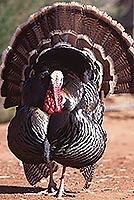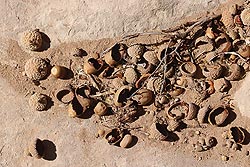 Turkeys are synonymous with November and the Thanksgiving holiday. Though it is unknown if the original menu the Pilgrims feasted on included wild turkeys back in 1621, perhaps the first “Thanksgiving” in the New World, they did dine on “wild fowl” as recorded by Edward Winslow, primary author of Mourt’s Relation: A Journal of the Pilgrims at Plymouth.
Turkeys are synonymous with November and the Thanksgiving holiday. Though it is unknown if the original menu the Pilgrims feasted on included wild turkeys back in 1621, perhaps the first “Thanksgiving” in the New World, they did dine on “wild fowl” as recorded by Edward Winslow, primary author of Mourt’s Relation: A Journal of the Pilgrims at Plymouth.
Prior to President Lincoln’s establishment of a national Thanksgiving holiday in 1863, some of his predecessor presidents took the liberty to declare a Thanksgiving Day celebration. But the national holiday didn’t really stick until Lincoln made it a national holiday. And of course, large family gatherings lent themselves to a large meal with a central star – the turkey.
Long before Lincoln and the Pilgrims, wild turkeys existed across the New World. In the American Southwest, archaeological excavations revealed these birds were domesticated over 2,000 years ago. Needing a source of feathers for robes or blankets and prayer sticks, what easier way existed then to collect feathers from cooped up birds. Interestingly, the birds were raised initially for their feathers and not as a food source, until around 900 A.D. when the taste for turkey became more prevalent in Puebloan society. This domestication concept is thought to have passed from the Aztecs northward into the Ancestral Puebloan culture.
Once widespread, wild turkey populations crashed with European settlement and westward expansion. By the 1930s, this majestic bird which once numbered an estimated 10 million across North America had been reduced to around 30,000 free-roaming birds. Efforts to staunch state declines at first failed because farm-raised turkeys had no idea how to survive in the wild. In the mid 1950s, Herman “Duff” Holbrook of South Carolina, an avid outdoorsman, came up with the concept of trapping wild turkeys with a net cannon and then transferring these wild birds to new locations. Soon other states adopted his “trap and transfer” program to reestablish turkey populations.
Today, in Utah, there are two subspecies of wild turkeys which roam the state: the Merriam’s and Rio Grande. Best separated by habitat, for the two subspecies are difficult to tell apart, the Merriam’s is more a forest bird, roaming ponderosa pine woodlands while the Rio Grande subspecies is more a riparian inhabitant.
Like domestic fowl, turkeys scratch the ground in search of nuts, berries, insects, and seeds. Their powerful gizzards can easily grind up Gambel’s oak acorns or serviceberry fruits. The males, known as Toms or gobblers, average about 20 pounds in the wild while females, or hens, weigh around 10 pounds.
By November, flocks of turkeys include young birds that have survived their fledgling stage. Near constant calling keeps the birds alert and aware of predators. When alarmed, the birds run with surprising speed but can also fly short distances and seek safety perched on a tree limb.
These and other characteristics led Benjamin Franklin in the 1780s to pen a letter to his daughter expounding on the virtues of the wild turkey over those of the bald eagle – the national symbol of a fledgling nation. Franklin was impressed with the fortitude of the turkey over the “fish stealing” nature of the bald eagle, and that spirit lives on in the wild birds that roam the Canyon Country.